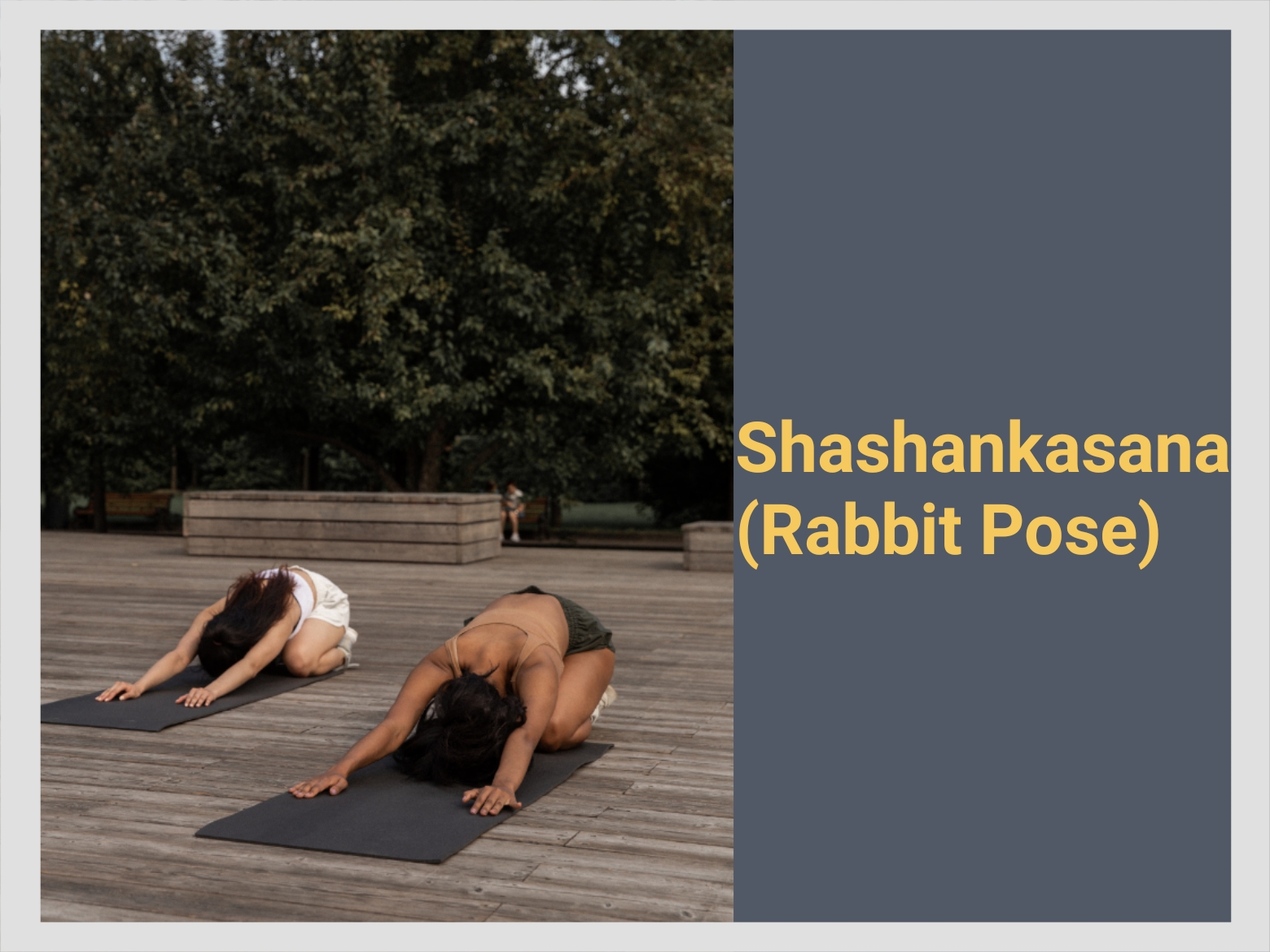Shashankasana (Rabbit Pose)
Shashankasana, also known as the Rabbit Pose, is a yoga asana (pose) that involves sitting on your knees and bending forward, reaching towards or holding your heels.
It’s a gentle stretch that primarily targets the spine, back, and neck muscles, while also promoting relaxation and flexibility. Remember to practice it safely and within your comfortable range of motion.

How to do Shashankasana (Rabbit Pose)?
♦ First of all, spread a carpet / mat or yoga mat on a clean and flat place.
♦ Now sit in Vajrasana.
♦ After sitting in Vajrasana, while inhaling, raise both the hands straight above the head.
♦ Now slowly while exhaling bend forward without bending your hands until your forehead touches the ground.
♦ The touch of hands and elbows should be with the ground.
♦ Hold your breath for some time according to your capacity (kumbhaka) and remain in this position.
♦ Inhaling slowly return to the starting position.
♦ Repeat this action ten times according to your capacity.
Benefits of Shashankasana (Rabbit Pose)
(1) Spine Health:
This asana is extremely beneficial for the spine, improving its strength and alignment.
(2) Back Pain Relief:
This asana helps in reducing back pain and provides relief by stretching the back muscles.
(3) Body flexibility:
Shashankasana promotes the flexibility of the body and helps in flexing the muscles.
(4) Neck and back pain:
This asana helps in reducing neck and back pain and provides stability to the areas that ache.
(5) Mental peace:
Through Shashankasana, mental stress can be reduced and mental peace can be felt.
(6) Stability of attention:
With this asana, stability of attention and greater stability of mind can be achieved.
(7) Effects on the Digestive System:
This asana can help the digestive system to work in a structured manner and improve your digestion.
(8) Peace of Mind:
Through Shashankasana, your mental state can improve and your mind can get peace.
Mental benefits of Shashankasana:
Peace of mind: Practicing Shashankasana brings mental peace and a calm intellect.
Mental stability: This asana helps in promoting mental stability and reduces mental stress.
Stability of attention: Through Shashankasana, stability of attention can be increased and aids the process of meditation.
Self-realization: This asana can encourage the process of self-realization and help you understand yourself better.
Stable Mindset: By practicing Shashankasana, mental stability is improved. And you are helped to control your feelings and thoughts.
Self-confidence: Practicing yoga improves self-confidence and self-perception, which makes you feel stronger.
Improvement of mental state: The practice of this asana improves your mental state and reduces your mental stress.
Self-realization: This asana helps you to better understand your self-experience and helps you to identify the most important matters related to yourself.
Precautions of Shashankasana (Rabbit Pose)
Precautions to be taken while doing Shashankasana:
Knee problem: If you have a problem with your knees, then this asana should be avoided.
Pregnancy: Do not do this asana during pregnancy, as it may cause strain.
Back pain or injury: Avoid doing the asana if you have back pain or injury.
Respiratory problems: If you have respiratory problems, this asana should be avoided.
Attention: Listen to your body while doing the asana and if there is any unusual pain or comfort problem, leave the asana immediately.
Frequently Asked Questions
What is shashankasana?
Shashankasana, also known as Child's Pose, is a yoga pose that involves kneeling on the floor with your buttocks resting on your heels and your torso folded forward over your thighs. Your arms can be stretched out in front of you or placed alongside your body. This pose is often used for relaxation and stretching the back, hips, and shoulders. It's a great way to release tension and calm the mind during a yoga practice.
What is shashankasana and it's benefits?
improve heart health, reduce lower back pain, lowering cholesterol levels and enhance digestion.
What is the procedure of shashankasana?
Start by sitting on your knees in a comfortable kneeling position, with your feet together and toes pointing backward. Place your palms on your thighs, keeping your back straight and shoulders relaxed. Inhale deeply, lifting your arms overhead. As you exhale, slowly bend forward from your hips, reaching your hands and forehead towards the floor in front of you.
Who should not perform shashankasana?
Shashankasana (Rabbit Pose) is generally safe for most people, but there are certain individuals who should avoid or modify this pose. Knee injuries or issues, Pregnancy, High blood pressure, Herniated disc or back injuries, Recent abdominal surgery, Vertigo or dizziness: If you experience frequent dizziness or have vertigo, avoid forward bending poses like Shashankasana.
Which part of back gets stretched in shashankasana?
The pose primarily targets the muscles in the lower back, middle back, and upper back, helping to improve flexibility and release tension in these areas. Additionally, the neck and shoulder muscles also experience a mild stretch as you reach your forehead towards the floor.
What is the duration of shashankasana?
The duration of Shashankasana (Rabbit Pose) can vary depending on your comfort level and experience with the pose. As with any yoga asana, it's best to hold the pose for a duration that feels comfortable and safe for your body. For beginners, it's recommended to hold Shashankasana for about 20 to 30 seconds, gradually increasing the duration as you become more familiar with the pose and your body's flexibility improves.
Read Also
- What is asana, its types and benefits
- What is pranayama, types and benefits
- What is yoga therapy, its importance and benefits
- Benefits of Padmasana (Lotus Pose) and How to Do it (precautions)